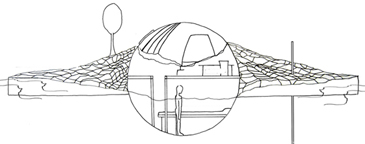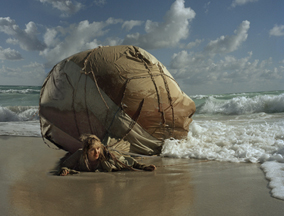
The first Waterpod concept sketch, 2006; Mattingly with early model of the Waterpod composed of trash collected from the Newtown Creek, on the Brooklyn/Queens border, 2008; and The Waterpod at South Street Seaport, Manhattan, 2009
link to Mary Mattingly's image log >
The Origins and Evolution of the Waterpod
Several months of conceptual work included creating: designs; theoretical treatises describing the mission and objectives of the Waterpod; business plans and budgets; maps and itineraries; one-page descriptive documents, two-page descriptive documents, architectural layouts; and artistic and scientific programming timelines. Pages and pages of grant applications were prepared to put this project in front of the appropriate city, state, and federal agencies ranging from the United States Coast Guard, to the NYC Dockmaster Unit, to our legal counsel Blank Rome, to barge companies, art collectors, investors, in-kind donors (solar panels and water purification equipment, towing services and shipyard facilities), and fiscal sponsors. I also established an LLC to assume the financial and operational risk.
Creating a cohesive support network among government, legal, private, and public groups was essential for this project to gain the support needed to execute such an undertaking as a public space and water-based art project in New York City. Before we even started the buildout, the Waterpod represented hundreds of thousands of dollars of work contributed on an in-kind and pro bono basis, without which, this project would never have gotten off the ground.

The first drawing of the Waterpod, 2006 -M. Mattingly
In one capacity or another, many people stood by me throughout the entire journey believing that the project would become reality: Mira and Derek Hunter, Eve K. Tremblay, Leslie Bocskor, and Cory Mervis.
A few key people reached out at critical points to move the project forward. Among these are Allison Jaffin at NYC Deputy Mayor Patti Harris’s office, Jamie Bennett at the Department of Cultural Affairs, and Maxeme Tuchman from the Mayor’s Office of Special Projects. Richard Singleton from Blank Rome, LLC and his colleague Glen Oxton met with me regularly to review my progress. They convinced the Blank Rome Executive Committee to take on the project as a pro bono assignment. When the Waterpod was able to draw support and inspiration from these individuals, the missing pieces fell into place.
As the project began to develop a solid base of support, other highly talented teammates came on board, including John McGarvey, Alison Ward, Carissa Carman, Lonny Grafman, Dockmaster Frank J. Carnesi, Rik van Hemmen at Martin Ottaway, Evan Korn and Jessica Rosenfield at the NYC Mayor’s Office of Citywide Events Coordination and Management, U.S. Coast Guard Commander Brian S. Gilda, Sara Reisman at Percent for Art, Ken Hollenbeck, Richard Massey, and many others. In the final stages of planning, other invaluable collaborators joined our effort, weaving the fabric that made the Waterpod work, including co-curator Ian Daniel, Mayra Ciment, Nicole Pilar, Kristen Parker, Janet Persia, and scores of talented and enthusiastic volunteers.
Thank you to everyone who helped realize the Waterpod in NYC 2009. This project will continue to grow and change within the next few years.
Temporary Housing Solutions and The New Mobility of Home:
This project continues to be a work in progress that demands simultaneous
creative engagement of producers, designers, builders, visitors,
residents, and guests. The design of Waterpod is made up of
a mode of social, political, and ecological actions and engagements
that describe mobility, community, and autonomy while
respecting water, nature and natural systems. Waterpod is an
expression of a collective intent, based on available
resources, trial and error, as well as an object and a space
that continues to be negotiated through democratic participation
and implementation.
The Waterpod is an extension of body, of home, and of community,
its permanence being change. It connects river to visitor, global
to local, nature to city, and historic to futuristic ecologies. It was integral to the point of the project that the space be both an inclusive
public resource and an experimental private dwelling, an interior
and exterior malleable space, an aquatic and terrestrial mobile
hybrid.
In preparation for our coming world with an increase in population,
a decrease in usable land, and a greater flux in environmental
conditions, people will need to rely closely on immediate communities
and look for alternative living models; the Waterpod is about
cooperation, collaboration,and augmentation.
With this project, we hope to encourage innovation as we visualize
the future fifty to one hundred years from now. The Waterpod
embodies self-sufficiency and resourcefulness, learning and
curiosity, human expression and creative exploration. It intends
to prepare, inform, and provide an alternative to current and
future living spaces.

Inflatable Home, 2008 -Mary Mattingly
link to Robert Mann Gallery >
lectures >
>>




